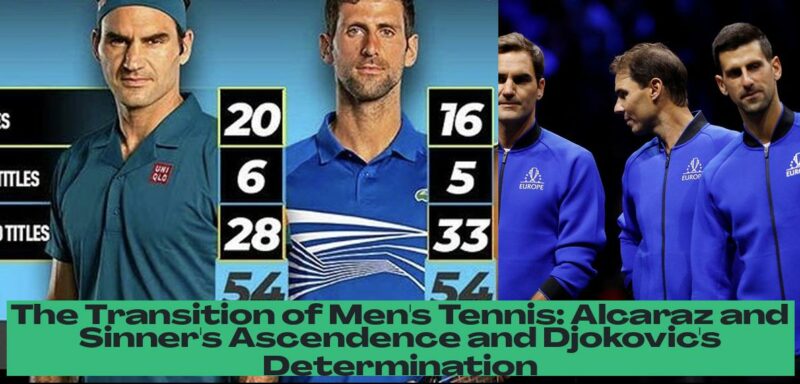Tennis’s ‘Big Three’ Transition: The Rise of Alcaraz and Sinner and the Resolve of Djokovic
The world of men’s tennis has always been a fascinating tapestry of talent, strategy, and sheer athleticism. But in recent years, the sport has been dominated by a formidable trio—Roger Federer, Rafael Nadal, and Novak Djokovic—collectively known as the “Big Three.” Their dominance has been so profound that it’s left many wondering what the future holds for the sport once they inevitably step aside.
The question of who would inherit the mantle of these legends has been a hot topic for some time now. And while the answer is far from definitive, the emergence of two young stars, Carlos Alcaraz and Jannik Sinner, has injected a much-needed dose of excitement and intrigue into the tennis landscape.
Their rise to prominence has coincided with Djokovic’s unwavering determination to remain a major force in the sport, even as he approaches the twilight of his career. His resilience has ensured that winning a Grand Slam remains a monumental achievement, demanding an immense level of skill and courage.
The transition from the “Big Three” era is a tale of both continuity and change. Djokovic’s presence continues to inspire awe and respect, while Alcaraz and Sinner are poised to usher in a new era of dominance. Let’s delve deeper into this captivating narrative and explore the key factors shaping the future of men’s tennis.
- The “Big Three” era in men’s tennis, dominated by Federer, Nadal, and Djokovic, has been a time of unparalleled dominance in Grand Slam tournaments.
- Carlos Alcaraz and Jannik Sinner are two young stars who are emerging as potential successors to the “Big Three,” injecting excitement and intrigue into the tennis landscape.
- Novak Djokovic’s unwavering determination and resilience as he approaches the twilight of his career have solidified his position as a major force in the sport.
- The transition from the “Big Three” era signifies a blend of continuity and change, with Djokovic’s continued presence inspiring awe while Alcaraz and Sinner represent the new generation poised for dominance.
- The dominance of Federer, Nadal, and Djokovic has made it challenging for other players to establish themselves as major contenders, creating anticipation for when the era of the “Big Three” will eventually come to an end.
The ‘Big Three’ Era: A Time of Unparalleled Dominance
The “Big Three” era has been a golden age for men’s tennis. From 2003 onwards, Federer, Nadal, and Djokovic have consistently dominated the Grand Slam tournaments, accumulating an astonishing number of titles between them. Their rivalry has been fierce and captivating, producing some of the most memorable matches in the history of the sport.
The dominance of these three players has created a unique dynamic in tennis. Their consistent success has made it incredibly difficult for other players to break through and establish themselves as major contenders. This has led to a sense of anticipation and excitement as the world eagerly awaits the moment when the “Big Three” era comes to an end.
The question of succession has become a constant topic of discussion, with many wondering who will emerge as the next generation of champions. The pressure to fill the void left by these legends is immense, and the journey towards establishing a new order in men’s tennis is just beginning.
The Emergence of Alcaraz and Sinner: A New Breed of Talent
As the “Big Three” era began to wind down, two young players—Carlos Alcaraz and Jannik Sinner—have emerged as the most likely candidates to take over the throne. Both are incredibly talented and possess the potential to become dominant forces in the sport.
Alcaraz, with his explosive athleticism and aggressive playing style, has already captured the hearts of fans around the world. He has a remarkable ability to hit winners from every corner of the court and has shown a remarkable maturity for his age. His impressive Grand Slam record, including victories over Djokovic, stands as a testament to his talent and potential.
Sinner, known for his powerful groundstrokes and tactical brilliance, is another rising star making a significant impact on the men’s tour. His composure and ability to handle pressure have been evident in his performances against top players. He has already achieved significant success, including a Grand Slam title at the Australian Open, which he won after defeating Djokovic in the semifinals.
The emergence of these two young players is a sign that the future of men’s tennis is in good hands. Their talent, ambition, and dedication are inspiring a new generation of tennis enthusiasts.
Djokovic’s Unwavering Resolve: A Force to Be Reckoned With
While Alcaraz and Sinner are poised to shape the future of men’s tennis, Djokovic remains a formidable force to be reckoned with. At 37, he continues to challenge the younger generation, proving that age is just a number. His commitment to excellence and relentless pursuit of victory are evident in his consistent performances at the highest level of the sport.
Djokovic’s presence in the Grand Slam tournaments ensures that winning remains a monumental achievement. He has consistently pushed his opponents to their limits, even when facing younger and more agile players. His determination to remain a major factor in men’s tennis has made the transition from the “Big Three” era even more compelling and exciting.
Djokovic’s refusal to fade into the background highlights the importance of perseverance and dedication in achieving greatness in sport. His presence as a competitive force in the latter stages of his career serves as an inspiration to younger players and reinforces the idea that age is not a barrier to achieving greatness.
The Transition: A Tapestry of Continuity and Change
The transition from the “Big Three” era is a complex process that involves both continuity and change. While the dominance of Federer, Nadal, and Djokovic has shaped the landscape of men’s tennis for over two decades, the emergence of Alcaraz and Sinner signifies a new era of talent and ambition.
Djokovic’s unwavering resolve has ensured that winning a Grand Slam remains an incredibly challenging task, even as the younger generation ascends. His presence as a competitive force continues to inspire a sense of respect and awe among players and fans alike.
The future of men’s tennis is a fascinating mix of old and new, with Djokovic providing a bridge between the “Big Three” era and the next generation of stars. As Alcaraz and Sinner continue to rise, the rivalry between them and Djokovic will undoubtedly shape the future of the sport. These three players represent different generations, styles, and approaches to the game, creating a dynamic and compelling landscape for fans to enjoy.
The Future of Men’s Tennis: A New Chapter Begins
The transition from the “Big Three” era is a natural progression in the world of sports. As one generation of champions steps aside, a new generation emerges, ready to take their place on the world stage. Alcaraz and Sinner are poised to lead this charge, and their rivalry with Djokovic will undoubtedly shape the future of men’s tennis.
The arrival of these young talents promises a new and exciting chapter in the history of the sport. Their unique styles, unwavering determination, and competitive spirit will inspire a new generation of tennis fans. The future of men’s tennis is bright, and the world is eagerly awaiting the next chapter in this captivating story.









